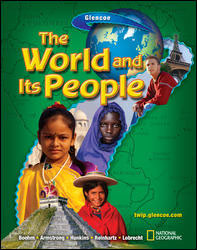
The World and Its PeopleChapter 7: Central America and the Caribbean IslandsChapter OverviewsCentral America is an isthmus that connects North America and South America. The seven countries that make up Central America are Belize, Guatemala, El Salvador, Honduras, Nicaragua, Costa Rica, and Panama. A chain of volcanic mountains runs through inland Central America with lowlands on both sides. Most of Central America has a tropical climate. Farming, on plantations or subsistence farms, is the major economic activity of this region. In the rain forests of Central America, valuable resources and ancient ruins of past empires can be found. The Panama Canal provides employment for nearly half of that country's people. Most countries in Central America have a blend of Native American and Spanish cultures. The Caribbean region includes three different island groups: the Bahamas, the Greater Antilles, and the Lesser Antilles. Many of the islands are part of an underwater chain of mountains formed by volcanoes. These islands lie within the Tropics, and most have a tropical savanna climate. Tourism and farming are the most important economic activities in the Caribbean. Most peoples of the Caribbean are a mix of African and European ancestry. |  |















